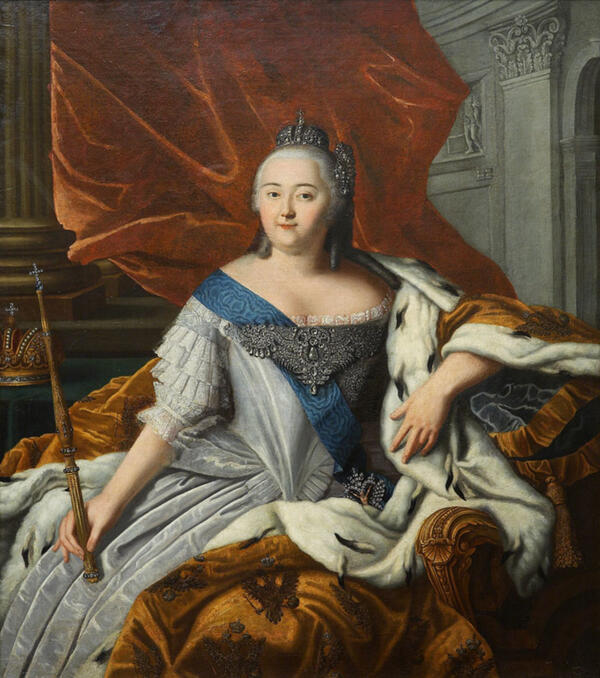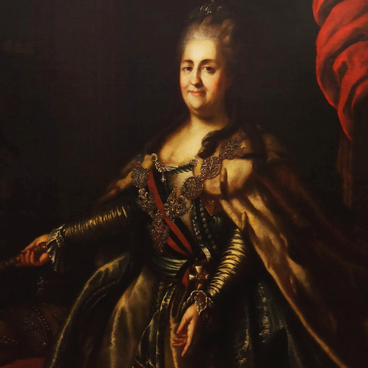The portrait of Empress of Russia Elizabeth Petrovna is a classic ceremonial portrait that came to Russia from Europe in the 18th century. According to the rules for drawing portraits of this type, the empress is depicted in a special solemn atmosphere of a palatial interior, in a luxurious dress with jewelry and the indispensable symbols of power - scepter, crown, and a stately cloak. The rules for such paintings were obligatory, since these artworks adorned the ceremonial halls and were intended for public viewing. Thus, ceremonial portraits easily fit into the decoration of palace chambers, arousing admiration for their beauty and grandeur.
When creating the painting, the artist addressed the well-known work of the 18th century - a spectacular ceremonial portrait of Catherine I by French painter Jean-Marc Nattier (March 17, 1685, Paris - November 7, 1766, Paris), painted in 1717. The portrait became popular and was considered a standard throughout the century. Following the rules for painting a portrait, the unknown author improvised with details. He slightly corrected the angle, changed the style of the dress and jewelry, put a scepter in Elizabeth’s right hand. According to the etiquette, the order with the ribbon was also replaced. The ruling empress was to be presented with the highest state award: the order and blue ribbon of St. Andrew the First-Called.
However, much in the work remains unchanged. The figure of the Empress stands out favorably against the background of a red velvet curtain with spectacular folds, a traditional detail of a ceremonial portrait. The Empress’s status is also emphasized by the choice of palatial interior fragment: on the left is a majestic column, on the right is a finely painted pilaster with a Corinthian capital and bas-reliefs. All painted portraits were under special control of the Empress herself. Therefore, the artist tended to create a somewhat idealized image of Elizabeth Petrovna. He tried to emphasize everything that Elizabeth’s contemporaries often mentioned in their memoirs: white skin, a slight blush on her cheeks, a blissful pleasant smile, grace, and refined manners.
When creating the painting, the artist addressed the well-known work of the 18th century - a spectacular ceremonial portrait of Catherine I by French painter Jean-Marc Nattier (March 17, 1685, Paris - November 7, 1766, Paris), painted in 1717. The portrait became popular and was considered a standard throughout the century. Following the rules for painting a portrait, the unknown author improvised with details. He slightly corrected the angle, changed the style of the dress and jewelry, put a scepter in Elizabeth’s right hand. According to the etiquette, the order with the ribbon was also replaced. The ruling empress was to be presented with the highest state award: the order and blue ribbon of St. Andrew the First-Called.
However, much in the work remains unchanged. The figure of the Empress stands out favorably against the background of a red velvet curtain with spectacular folds, a traditional detail of a ceremonial portrait. The Empress’s status is also emphasized by the choice of palatial interior fragment: on the left is a majestic column, on the right is a finely painted pilaster with a Corinthian capital and bas-reliefs. All painted portraits were under special control of the Empress herself. Therefore, the artist tended to create a somewhat idealized image of Elizabeth Petrovna. He tried to emphasize everything that Elizabeth’s contemporaries often mentioned in their memoirs: white skin, a slight blush on her cheeks, a blissful pleasant smile, grace, and refined manners.



